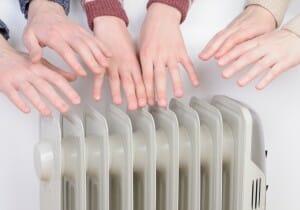HealthStatus.com

Cold hands and feet can be as simple as being where it is cold. The body’s natural temperature can also cause cold hands and feet or cold hands and feet can be a result of real medical issues. Problems with blood circulation, small blood vessels in your hands or any number of other medical mysteries can cause of hands and feet.
A list of diseases that cause cold hand and feet include:
- Frostbite
- Anemia
- Diabetes
- Lupus
- Raynaud’s Disease
- Scleroderma
- Buerger’s Disease
- Thyroid Disease
- Poor circulation
- Nervous system disorders
If you occasionally have cold hands and feet don’t be alarmed. However if persistently cold hands and feet are associated with changes in skin color or are continual you may have a problem with nerves or blood circulation. You may also be experiencing tissue damage in your hands or feet.
Is this why your feet are so cold? #HealthStatus
Disease that Trigger Cold Hands and Feet
- Frostbite is not a disease but a condition of being out in extreme cold weather. Damage to skin and tissues is due to freezing. Severe frostbite kills the muscles, tendons, blood vessels, and nerves. The skin shrinks and tears. A loss of feeling is a symptom and gangrene can be the result.
- Anemia often causes extreme pale skin fatigue, weakness and cold hands and feet. Iron deficiency anemia often goes undiagnosed until you experience Raynaud’s disease. If your hands and feet stay cold despite warming measures, check your iron levels.
- Diabetes causes different types of problems and including cold hands and feet due to circulatory problems, high blood pressure and thyroid problems.
- Lupus may be a contributor to cold hands and feet. Blood vessels come under attack with systemic lupus. Small blood vessels in the skin of hands and feet and prevent normal blood movements. Icy hands and feet are the result.
- Raynaud’s Disease or blood vessels in the hands and feet overacting to cold temperatures or stressful situations are a major cause of freezing hands and feet. Raynaud’s disease triggers arteries in fingers and toes to enter vasospasm or a condition that narrows your blood vessels and limits blood supplies to the extremities. Over time these arteries thicken which further limits blood flow. One symptom is a pale and or dusky color to your fingers and toes.
An attack of Raynaud’s can be started by cold water on hands and feet, holding a cold item, exposure to cold air or emotional stress. Primary Raynaud’s has no underlying medical issue that contributes to severe cold hands and feet. It is simply an inherited disorder with inconvenient symptoms.
Secondary Raynaud’s may be a serious disorder caused by different underlying diseases. One disease is scleroderma or a rare disease that causes hardening and scarring of our skin. Lupus is an autoimmune disease characterized by shrinking blood vessels located in the hands and feet. Rheumatoid arthritis may be an underlying factor to Raynaud’s and diseases of the arteries can be culprits.
- Artery damage and diseases such as atherosclerosis or the buildup of plaque in the bloods vessels can be an underlying condition of cold hands and feet or Raynaud’s phenomenon.
- Carpal tunnel syndrome or a condition with pressure being placed on the nerve in the wrist causes pressure, pain, tingling, cold and numbness in the affected hand. Raynaud’s and cold hands are symptoms of carpal tunnel syndrome.
- Smoking cause blood vessels to constrict. If you are chronic smoker you may find your hands and feet are constantly cold.
- Beta blockers used to treat high blood pressure; migraine medications and some over the counter cold medications have been linked to cold hands and feet and contribute to Raynaud’s.
- Working with vinyl chloride in the plastics industry can cause scarring and pitting in your hands. This leads to Raynaud’s disease and cold hands.
Additional factors that can lead to cold hands and feet and/or Raynaud’s disease are gender, age, cold climates and family history. Question your immediate family and determine if they have primary Raynaud’s.
Treating Cold Hands and Feet
If your cold hands and feet symptoms are related to Raynaud’s disease or are chronic and disturbing there are medication that can help. To dilate blood vessels and encourage circulation you can use calcium channel blockers, alpha blockers, and vasodilators.
[pel_getmldata healthy=’yes’ numrec=3]
Do not take over the counter cold medications, beta blockers, or birth control pills if you have chronic cold hands and feet or discolored pale skin.
Nerve surgery may relieve your Raynaud’s symptoms. Nerves are cut around blood vessels through small incisions in the hands and feet. This type of surgery is called sympathectomy and helps reduce the frequency of cold hands and feet attacks. Do be aware that this surgery is not always successful.
Chemical injections to block sympathetic nerves in your affected limbs can help. You will have to have these injects repeated.
Amputation or removing tissue damaged from a lack of blood flow might be necessary. If the blood supply to your hands and feet is completely blocked, gangrene may develop. This is very rare however.
Stop smoking. Smoking causes your skin temperature to drop and blood vessels to constrict. Exercise regularly to increase your circulation to affected areas. Control your stress levels. Stress can trigger an attack or Raynaud’s. Avoid caffeine. Caffeine contributes to blood vessel narrowing. Take care of your hands and feet. Guard them from injury and avoid walking barefoot. Keep your nails clipped and groomed. Avoid wearing constricting gloves, socks or shoes. Do avoid using tools that vibrate the hands. Do not wear rings, watches and bracelets that are tight.
If you experience cold hands and feet, move to a warmer area, place your hands and feet under warm running water, massage hands and feet and wiggle your fingers and toes.
Take fish oil supplements to improve tolerance to cold. Biofeedback or mind body temperature control using guided imagery can help. Therapists can teach you biofeedback techniques.
Dress appropriately when outdoors in the cold. Wear socks and when taking food out of the freezer, use oven mittens or gloves. Set your air condition to a warmer temperature to prevent cold hands and feet. If you live in a cold climate, you might want to consider moving to a warmer location. Be practical if you have chronic cold hands and feet. Be aware of underlying medical conditions, dress warm in cold climates and weather, and use warming techniques.
___
https://www.healthstatus.com/health_blog/heart-disease-2/medical-cold-hands-feet/
